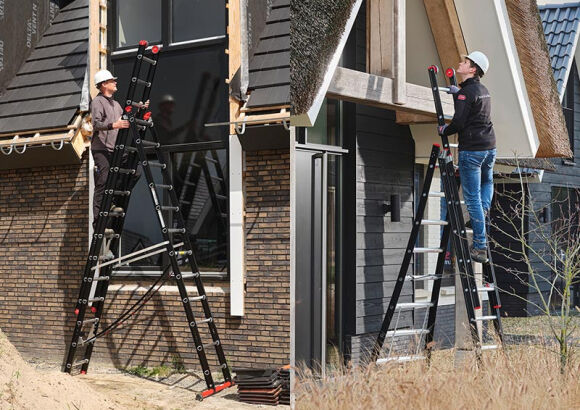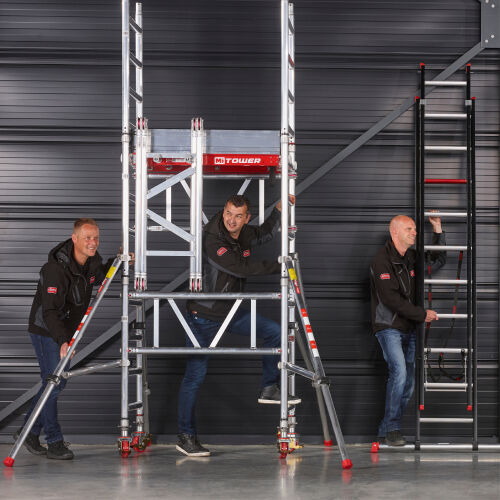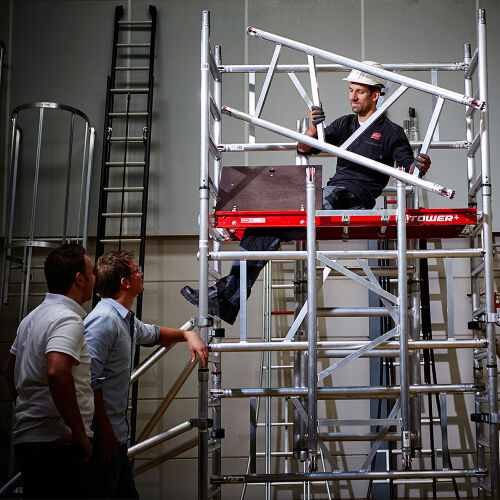How do you extend your ladder?
There’s nothing nicer than getting your Altrex ladder from the shed or getting a new one from the DIY store. But before you begin, it is good to always check the best way to extend and retract your ladder without causing any accidents. If you remember, there were some useful tricks for this. This blog tells you everything there is to know about extending and retracting (telescopic) ladders.
Perhaps you will also find this interesting:

How should you extend your ladder?
Ladders come in different shapes and sizes, yet they basically all work the same. Whether you own an extendable ladder or a combination ladder, extending the ladder is often done the same way.
You always place the ladder on a flat and stable surface. The National Institute for Public Health & the Environment (Dutch: RIVM) reports that approximately 45% of all accidents with ladders are caused by incorrect positioning of the ladder. In order to prevent the ladder from slipping away on slippery surfaces, you can use a ladder mat. When the ladder is standing sturdily and firmly, unlock the top section of the ladder, extend it to the necessary height and relock it. If you have a 3-part ladder, then repeat these steps with the middle ladder. When retracting the ladder, it is important to always first unlock the middle part, retract it and lock it and only then do the same for the top section.
How far is my ladder allowed to protrude?
When you extend the top section of a 3-part ladder in the A-position, make sure that the red rung (or the fourth rung from the top) never protrudes beyond the hinge. If you extend your ladder beyond this, you can exceed the tipping point, making the ladder no longer safe to climb. We have developed the Red Step® to help you with this. The Red Step® instantly shows you what is the highest rung on which you can stand. It is also important that a single straight ladder protrudes at least one metre above the support surface.
Also interesting!
How should you extend your telescopic ladder?
The fact that you can completely retract a telescopic ladder makes it very compact and easy to transport to all your jobs, but what is important to know about extending and retracting a telescopic ladder?
Always place the telescopic ladder on a sturdy, firm, horizontal and non-slippery surface in which the feet cannot sink and/or slip. Place your foot on the lower rung to keep it in position when extending the ladder. When you want to completely extend the ladder, you begin with extending the upper rung and then extending the following rungs until it has extended completely. If you don’t want to extend the ladder all the way, then begin extending from the second lowest rung. Extend the following rungs to the desired height in such a way that the left-over rungs are stacked at the top.
In all cases, it is very important to check that every extended rung is locked. Check this by pressing down the rung above on both sides, after which you can trace the position of the bolts. If all the rung distances are the same, then your telescopic ladder is set up correctly!
When retracting the ladder, firmly hold the ladder in upright position with one hand on the stile of the ladder (preferably two rungs higher). With the thumb and forefinger of your other hand unlock the bolts on the rungs and gently guide the upper ladder sections down with your other hand. Retract the following rungs in the same way so in the end you get a retracted ladder. This prevents the risk of your fingers getting jammed.
Also interesting!

Would you like to receive more hints and tips?
Subscribe now to the Altrex newsletter to stay up to date on the latest developments and innovations, and you'll be first to receive the latest news.
Related articles
Which is best for you; a platform lift, or a passenger lift? We explain it to you here!

For every job an Altrex. But which ladder do you choose from such a wide range? We compare two of them side by side

Each project requires an appropriate solution. The RS TOWER 5 Series Modular Scaffolding System gives you the

If you work at heights, then you go for safety and quality. That's why you choose Altrex mobile rolling towers. From a







